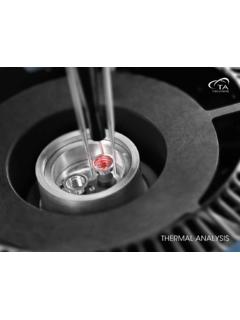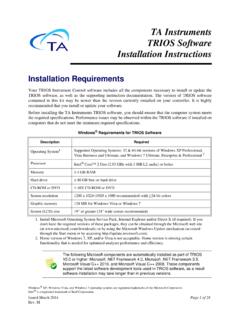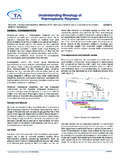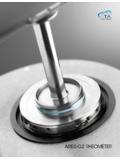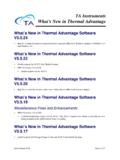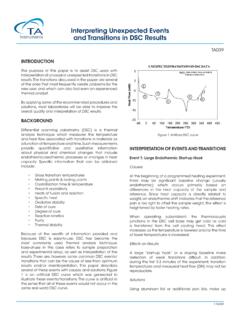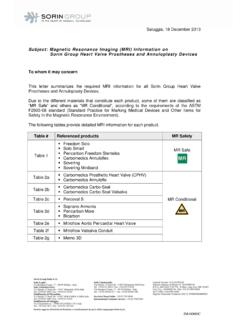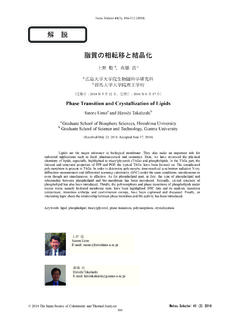Transcription of Thermal Analysis of Rubbers and Elastomers
1 Thermal Analysis of Rubbers and Elastomers Mackenzie Geiger Applications Scientist September 6, 2017. Thermal Analysis What does it measure and what is it used for? Thermal Analysis is a series of complementary techniques to measure various properties of materials as a function of temperature and time Thermogravimetric Analysis (TGA). Weight loss, weight gain, compositional and Thermal stability of a material. [Sorption Analysis ]. Provides information to aid in the interpretation of DSC data. Extremely complementary to DSC.
2 Differential Scanning Calorimetry (DSC). Measures Heat Flow into or out of a sample Modulated DSC Separates Heat Flow into Heat Capacity, Reversing and Non Reversing Heat Flow Thermomechanical Analysis (TMA). Determines dimensional changes of a material, coefficient of Thermal expansion, glass transition What Materials? Iron and Steel Aluminum and other metals (Mg). Adhesives and Sealants Textiles / Leather Rubbers and Elastomers Thermoplastic Polymers Composites Thermosets ans Resins Coatings and Paints Fluids and Lubricants Glass Other (electronics, fuel cell, gasoline, nano-materials, ceramics, sensors, etc.)
3 Agenda 1. Thermogravimetric Analysis Standard and Hi-Res TGATM, TGA-MS, Decomposition and Lifetime Kinetics 2. Differential Scanning Calorimetry Technique Overview, Conventional vs. Modulated DSC , Curing Kinetics Thermogravimetric Analysis (TGA). Thermogravimetric Analysis (TGA). TGA measures amount and rate of weight change vs. temperature or time in a controlled atmosphere Used to determine composition and Thermal stability up to 1000 C (Q50 1200 C (Discovery TGA) &. 1500 C (SDT). Characterizes materials that exhibit weight loss or gain due to decomposition, oxidation, or dehydration Mechanisms of Weight Change in TGA.)
4 Weight Loss: Decomposition: The breaking apart of chemical bonds. Evaporation: The loss of volatiles with elevated temperature. Reduction: Interaction of sample to a reducing atmosphere (hydrogen, ammonia, etc). Desorption. Weight Gain: Oxidation: Interaction of the sample with an oxidizing atmosphere. Absorption. All of these are kinetic processes ( there is a rate at which they occur). Decomposition of Elastomers in Nitrogen Volatilization of Plasticizers/Oils Styrene-Butadiene rubber Analysis 100.
5 Oil 75 Polymer Wt (%). 50 Air Carbon Black 25 Sample weight: 30 mg Program rate : 20 C/min Atmosphere : N2 , Air 5% Inert Filler 0. 0 200 400 600 800 1,000. Temperature ( C). Sample: Cured Tire Tread rubber Compoun Size: mg TGA of Tire rubber File: CURED TIRE TREAD rubber Run Date: 18-Nov-2005 12:06. 100. 12. Oil ( ). Polymer ( ) 10. 80. Deriv. Weight (%/min). 8. 60. Weight (%). TGA Analysis mg of Tire rubber Compound 20 C/min to 600 C in N2 6. 20 C/min to 1000 C in air Carbon ( ). 40. 4. 2. 20. Residue: ( ).
6 0. 0. 0 200 400 600 800 1000. Temperature ( C) Universal TA Instruments TGA of rubber in Nitrogen Sample: rubber 10C/min N2 - Green Colorant Size: mg 120. ( ) ( ). 100. C. 1. Deriv. Weight (%/ C). 80. Weight (%). C. 60. C. 40 Residue: ( ). 20 -1. 200 400 600 800 1000. Temperature ( C). TGA rubber in Air Sample: rubber 10C/min Air - Green Colorant Size: mg 120 6. C. ( ) ( ). 100. 4. Deriv. Weight (%/ C). 80. Weight (%). 2. 60. C. 0. 40. Residue: ( ). 20 -2. 200 400 600 800 1000. Temperature ( C). TGA rubber in Air vs Nitrogen 120 6.
7 rubber 10 Cmin Air - Green rubber 10 Cmin N2 - Green C. ( ). 100 ( ). 4. ( ) ( ). Deriv. Weight (%/ C). 80. Weight (%). 2. Residue: C C ( ). 60. C. Residue: ( ). 0. 40. 20 -2. 200 400 600 800 1000. Temperature ( C). Hi-ResTM TGA. In a Hi-ResTM TGA experiment the heating rate is controlled by the rate of decomposition. Faster heating rates during periods of no weight loss, and slowing down the heating rate during a weight loss therefore not sacrificing as much time Hi-ResTM TGA can give better resolution or faster run times, and sometimes both EPDM rubber by TGA & Hi-Res TGA.
8 Process Oil in a rubber Compound by Hi-Res TGA. TGA-Evolve Gas Analysis (EGA). TGA measures weight changes (quantitative). Difficult to separate, identify, and quantify individual degradation products (off-gases). Direct coupling to identification techniques (Mass Spec, FTIR) reduces this problem TGA-MS of Styrene Butadiene rubber (SBR). Sample: SBR File: C:..\Bnl\ rubber \tga\SBR\ Size: mg TGA Operator: Daniel ROEDOLF. Run Date: 31-Dec-01 16:31. Comment: Helium Instrument: AutoTGA 2950HR 90. 2mg sample He purge, Deriv.
9 Weight (%/min). 40 C/min Weight (%). 70. 50. 30. 0 100 200 300 400 500 600 700. Temperature ( C) Universal TA Instruments Fingerprint of Natural rubber vs SBR. 67. Natural rubber 67 91. Styrene Butadiene rubber Mass 45 to 170. Natural rubber Styrene Butadiene rubber N. Nitrile rubber N. Mass 100 to 200. Natural rubber Styrene Butadiene rubber Nitrile N. rubber N. Styrene Butadiene rubber 500 C. 64. 78. 48. 250 C. Deriv. Weight (%/min). 400 C. Weight (%). 250 C. 400 C. 0 100 200 300 400 500 600 700 800.
10 SBR Temperature ( C). 500 C. Decomposition and Lifetime Kinetics Simple Polymer Decomposition E . A exp . RT . E . ln A . RT . where heating rate ( C / min). A pre - exponential E Activation Energy (kJ / mol). T temperature (K). R Universal Gas Constant Simple Polymer Decomposition Experimental Run TGA experiment on polymer at 4 different heating rates. Use the same gas for each typically nitrogen or air. Obtain a temperature at an isoconversional point for example 2% weight loss for each heating rate Plot the ln of the heating rate ( ) versus 1/T (temperature units must be in Kelvin).



